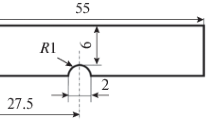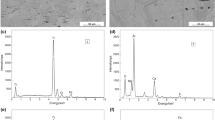Conclusions
-
1.
At temperatures from 20 to −120°C the impact strength for samples of types I, IV, and with a started crack was highest for Cr−Mn steel; at temperatures below −120°C the impact strength was highest for Cr−Ni steels (Kh18N10T and Kh18N20).
-
2.
The temperature dependences of the impact strength for austenitic Cr−Ni and Cr−Mn steels differ in principle. With lowering of the testing temperature the impact strength of the Cr−Ni steels decreases monotonically for all types of notch tested, while the Cr−Mn steel exhibits a distinct ductile-brittle transition temperature.
-
3.
The reduction of the work of crack propagation for austenitic Cr−Ni steels is accompanied by a change in the microstructure of the fracture surfaces — refining of the dimpled structure.
-
4.
The austenitic Cr−Ni steels undergo ductile fracture in the temperature range of +20 to −253°C. For the austenitic manganese steel one observed brittle fracture along with ductile fracture at temperatures below the upper cold brittleness threshold. With decreasing temperatures the amount of riverine structure increases, and at −253°C it is quite visible, comprising 60% of the fracture surface.
-
5.
The character of failure in these steels changes the existing concept of nonbrittle fracture for fee steels during low-temperature deformation. The determining factor in retention of the toughness (absence of embrittlement) of austenitic steels is evidently not only the type of lattice but also the chemical composition of the alloy (the presence of nickel).
Similar content being viewed by others
Literature cited
I. N. Bogachev et al., "Brittleness of austenitic Cr−Mn alloys," Metal. i Term. Obrabotka Metal., No. 8, 51–53 (1972).
A. P. Gulyaev and N. A. Sorokina, "Stability of austenite and properties of Cr−Ni stainless steels at low temperatures," in: Special Steels and Alloys [in Russian], No. 46, Metallurgiya, Moscow (1966) pp. 58–66.
A. A. Babakov and M. V. Pridantsev "Cr−Mn and Cr−Mn−Ni austenitic steels," in: Corrosion Resistant Steels and Alloys [in Russian], Chapter IV, Metallurgiya, Moscow (1971), pp. 144–173.
D. V. Lebedev and B. M. Ovsyannikov, "Effect of stress concentrations on the properties of steel for cryogenic applications," Problemy Prochnosti, No. 2, 70–77 (1972).
I. N. Bogachev and V. F. Egolaev, "Phase transformations and hardening during plastic deformation of Fe−Mn alloy with Mo and W," Fiz. Metal. i Metalloved.,18, No. 3, 423–427 (1964).
A. P. Gulyaev, Metal Science [in Russian], Metallurgiya, Moscow (1966).
N. N. Morgunova, "Brittle failure of metals," Metal. i Term. Obrabotka Metal., No. 1, 9–11 (1972).
A. P. Gulyaev and A. M. Minaev, "Impact strength of austenitic steels at low temperatures," Metal. i Term. Obrabotka Metal., No. 10, 45–47 (1966).
D. V. Lebedev and B. M. Ovsyannikov, "Method of applying a fatigue crack in impact test samples of ductile metals," Problemy Prochnosti, No. 12, 84–87 (1971).
A. P. Gulyaev, "Separation of the impact strength into its component parts from test data for samples with different notches," Zavod. Lab., No. 4, 473–475 (1967).
A. P. Gulyaev, V. D. Zelenova, and I. V. Shermazan, "Determining the cold brittleness threshold from electron fractographic data," Zavod. Lab., No. 7, 870–872 (1966).
V. D. Zelenova and I. V. Shermazan, "Electron microscopic method of quantitative analysis of ductile components in fractures," Zavod. Lab., No. 12, 1477–1479 (1972).
Additional information
Central Scientific-Research Institute of Ferrous Metallurgy. Translated from Metallovedenie i Termicheskaya Obrabotka Metallov, No. 9, pp. 8–12, September, 1973.
Rights and permissions
About this article
Cite this article
Gadzhibalaev, G.A., Gulyaev, A.P. & Lebedev, D.V. Toughness of Cr−Ni and Cr−Mn austenitic steels at low temperatures. Met Sci Heat Treat 15, 732–736 (1973). https://doi.org/10.1007/BF00656280
Issue Date:
DOI: https://doi.org/10.1007/BF00656280




